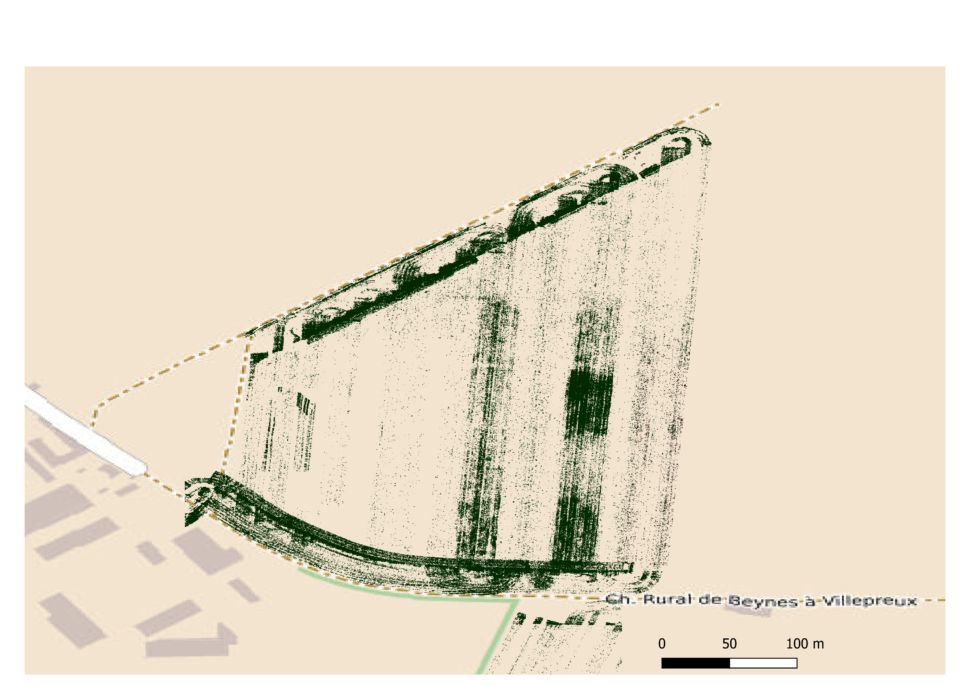The Precision Weeding Project led by the Alliance H@rvest aims to refine the usage conditions, effectiveness, and profitability of available or developing precision weeding tools for large-scale crops.

Project background
Weed management is a critical issue for large-scale crop producers. Keeping fields weed-free at economically and environmentally acceptable costs is essential for maintaining productivity and competitiveness (yield and crop health) in both the short and long term.
This issue has gained renewed attention with the introduction of the new Ecophyto 2030 national plan and the potential withdrawal of 75 active substances at the European level.
New technologies are a significant lever to help achieve this goal and maintain clean fields. Among these technologies, precision weeding is a major approach. This can involve sprayer booms capable of managing product application down to the nozzle level or using weeding robots.
The detection and spatial analysis of weed distribution are conducted either during an initial pass (using a tractor, drone, etc.) or in real-time by the tractor performing the treatment.
Recent studies show that the technology is effective and has begun to be applied in specific cases, particularly with perennial weeds that grow in patches. However, applying it to more crops and situations requires additional experimentation.
Moreover, this equipment is very expensive (e.g., €4,000 per meter of boom) and likely challenging to make profitable on average-sized farms in Western Europe.
Studying the conditions necessary to achieve profitability and potential amortization is a prerequisite for advancing the development of these techniques.
From an environmental perspective, all studies agree on a significant reduction in applied doses (often between 50% and 90%). As a result, the herbicide treatment index (IFT) can be substantially decreased, contributing to more sustainable modes of action for the products.
While the technology is well-developed and is beginning to be applied in specific scenarios, further experimentation is needed to expand its application to a broader range of crops and situations.

Project objectives
Partners within the Alliance interested in precision weeding propose to pool their expertise around a central goal: to refine the conditions of use, effectiveness, and profitability of available or developing precision weeding tools for large-scale crops.
Numerous operators are positioning themselves along different links in the detection and localized treatment chain of weeds. However, data on effectiveness and selectivity, optimal usage conditions, and more are still lacking and need to be supplemented by studies conducted in a greater variety of situations—crops, weed species, application conditions, etc. Beyond the somewhat specific use cases present in the literature, expanding the scope of possibilities is essential to further develop these technologies.
This primary goal can be broken down into several objectives:
- Technical Comparison of Tools or Processes:
- Detection and Spatialization Methods of Weeds:
- Compare the effectiveness of various detection technologies.
- Localized Spraying Methods:
- Assess the precision and reliability of targeted spraying techniques.
- Ease of Implementation Across the Entire Operational Chain:
- Evaluate how user-friendly and efficient the overall system is, from detection to treatment.
- Effectiveness and Selectivity Against Existing Weeds:
- Determine the effectiveness of these tools in controlling specific weed species while minimizing impact on crops.
- Determine the effectiveness of these tools in controlling specific weed species while minimizing impact on crops.
- Detection and Spatialization Methods of Weeds:
- Economic Comparison of Tools and Processes:
- Additional Costs Incurred by the New Technology:
- Analyze the financial implications of adopting precision weeding technologies.
- Possible Gains and Savings:
- Measure the economic benefits, such as reduced herbicide use or increased crop yield.
- Economic Evaluation “Per Field” or “Per Hectare”:
- Perform cost-benefit analyses at both the field and hectare levels.
- Feasibility and ROI at the Farm Scale:
- Assess the overall return on investment (ROI) for adopting these technologies at the farm level.
- Additional Costs Incurred by the New Technology:
- Social and Environmental Impact:
- Reduction of Doses (Herbicide Treatment Index – IFT) and Negative Externalities:
- Evaluate the potential for reducing herbicide use and its associated risks, such as weed resistance and health hazards.
- Improved Weed Control and Public Health:
- Explore the impact on public health by reducing harmful weeds like datura, ragweed, and nightshade.
- Farmer Autonomy: Advantages or Barriers?
- Investigate whether these technologies increase or decrease farmers’ independence and ease of operation.
- Environmental Impact (Including GHGs like CO2):
- Conduct a thorough environmental assessment, focusing on greenhouse gas emissions and other ecological factors.
- Reduction of Doses (Herbicide Treatment Index – IFT) and Negative Externalities:
This collaborative approach will help define the optimal conditions for using precision weeding tools, enhancing both their effectiveness and profitability while addressing important social and environmental concerns.
Expected project outcomes
Reporting and Dissemination Plan for Precision Weeding Project
- Experimental Reports:
- Documentation: Each weeding trial (1 crop x 1 location) will be documented in a report detailing the execution and key results obtained.
- Content: These reports will include descriptions of the experimental setup, methodologies, observed performance, and initial findings.
- Synthesis and Comparative Analysis:
- Aggregation: Results from individual trials will be aggregated and consolidated by crop type.
- Comparative Analysis: Conduct a comparative analysis of the various solutions against each other and traditional or mechanical weeding methods.
- Economic Analysis: The analyses will include economic aspects, such as cost-effectiveness and equipment amortization calculations under different purchasing or leasing scenarios.
- Technical Advice:
- Recommendations: Develop and disseminate recommendations to advisors and farmers regarding the implementation of these solutions. This will cover their benefits, limitations, and best practices.
- Publications and Outreach:
- Scientific Publications: The results will be published and highlighted through scientific articles (journals, conferences) to reach the academic and research communities.
- Technical Publications: Results will also be shared through technical media of partners, agricultural press, and social media platforms to inform and engage the broader agricultural community.


